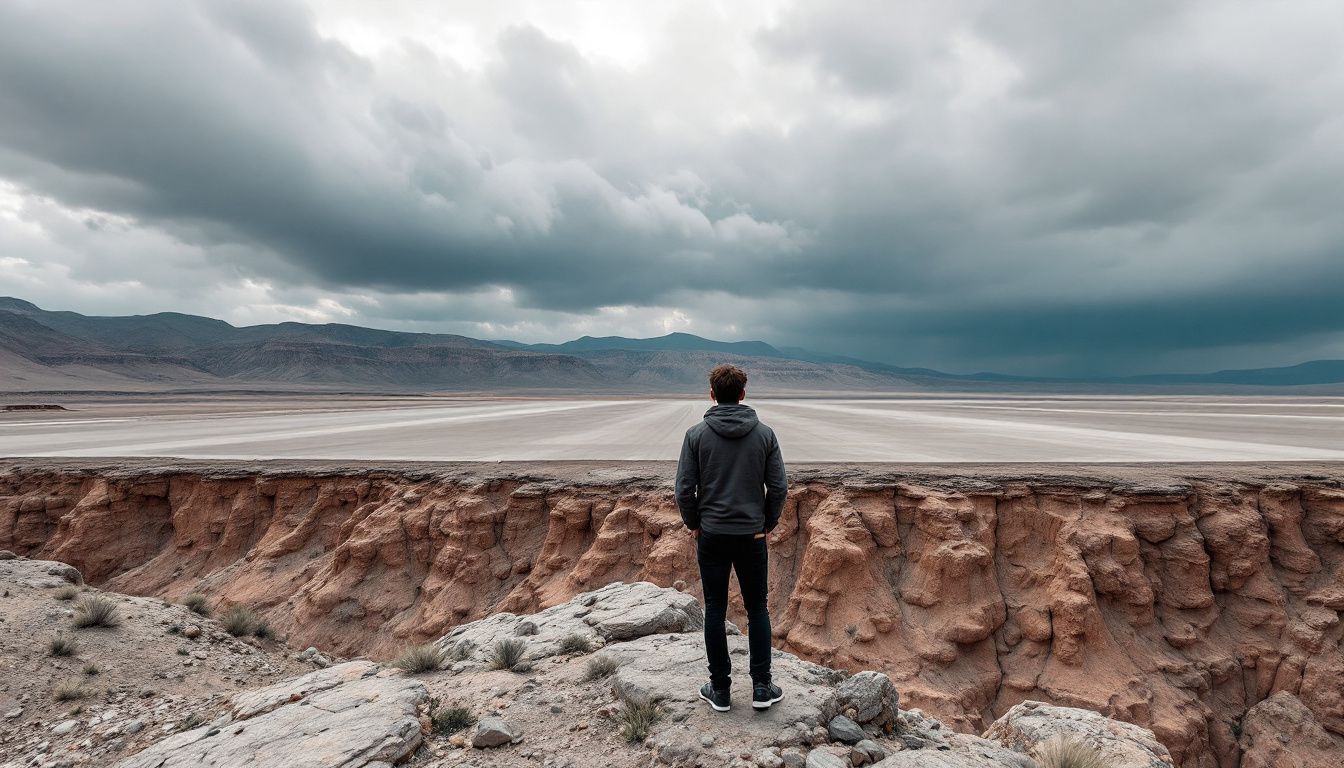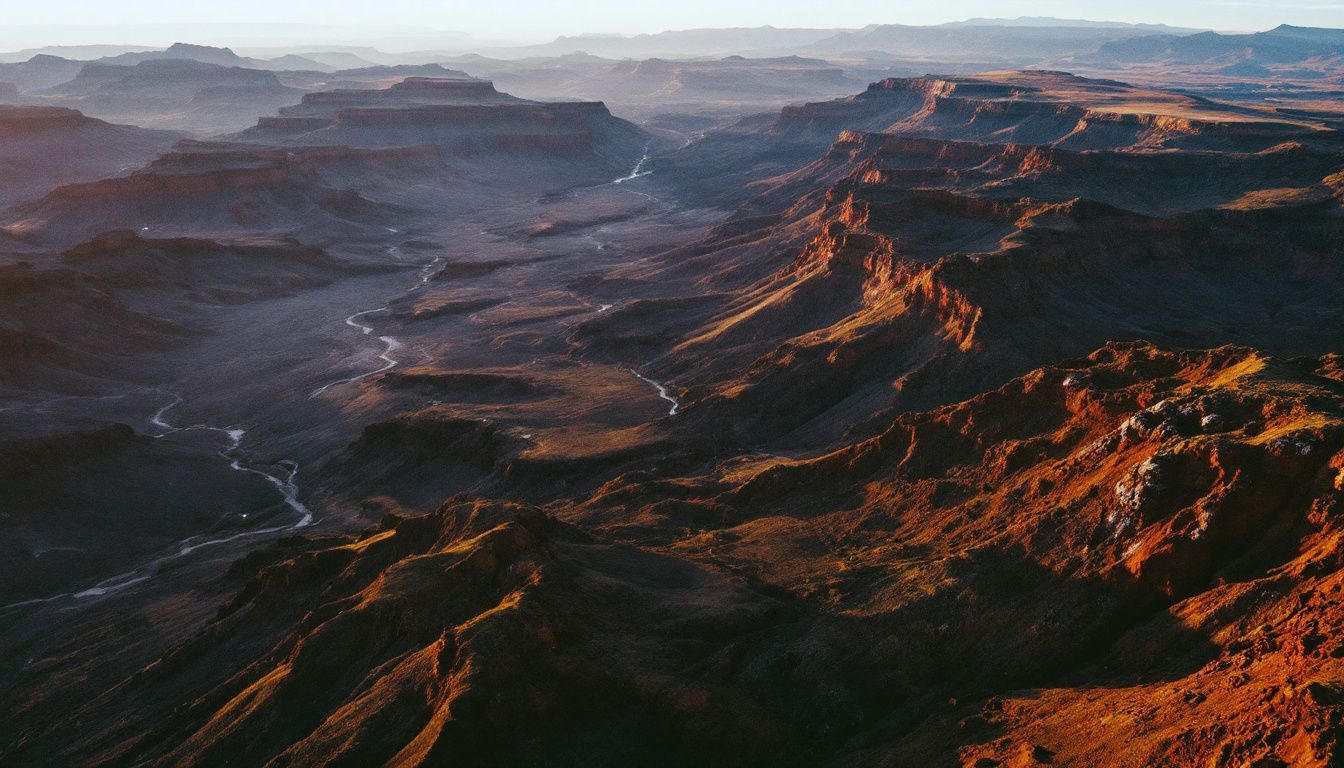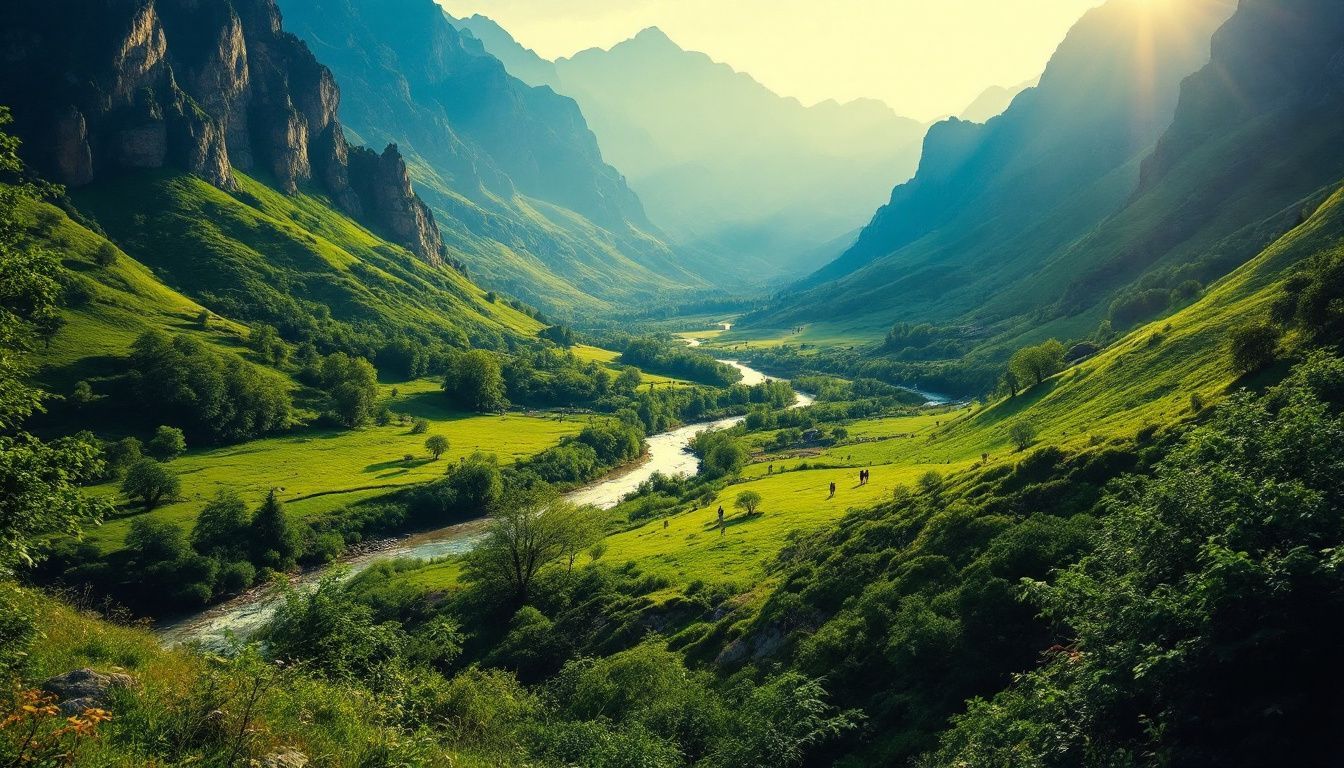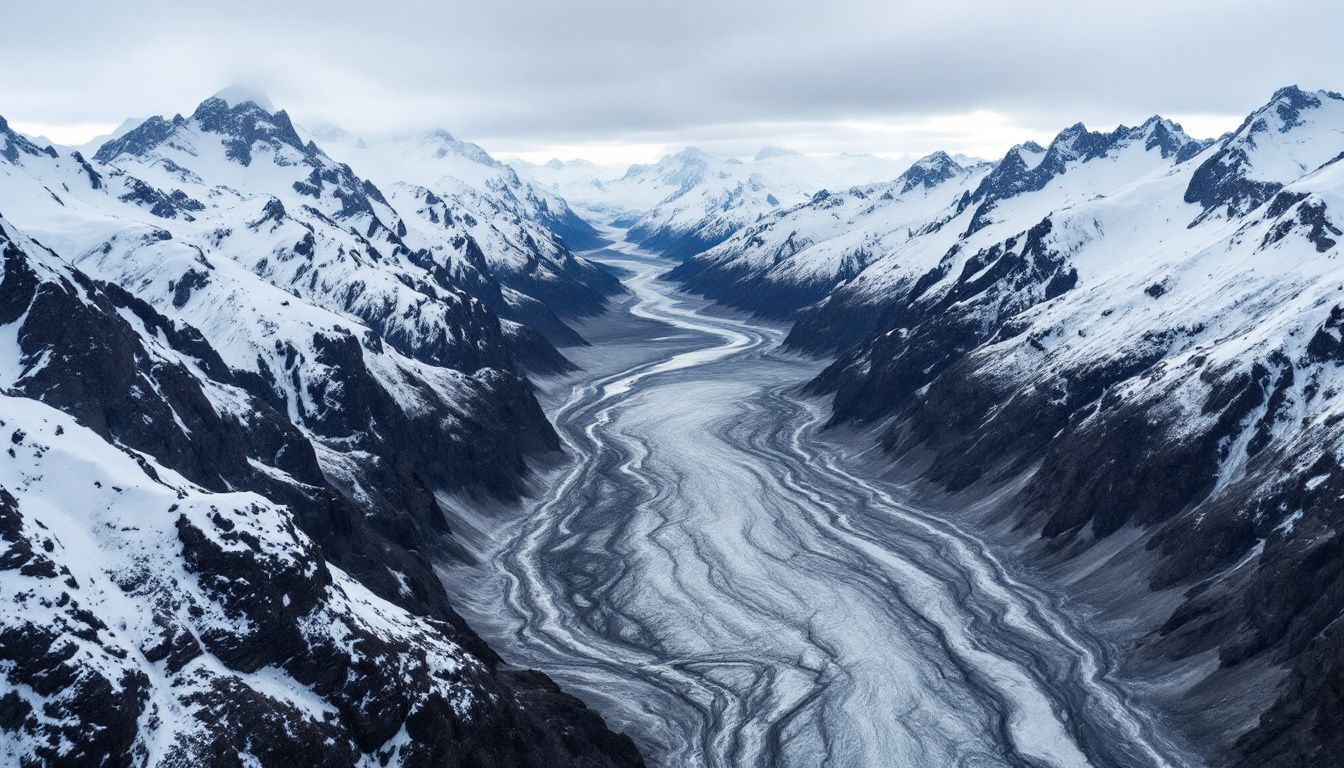Looking at a map or exploring the outdoors, have you ever wondered about the shapes and types of landforms you see? Maybe you find it tough to tell a plateau from a mountain or don’t know why plateaus have those flat tops.
You’re not alone. Many people find these natural structures fascinating yet confusing.
Here’s something to ponder: mountains, plateaus, valleys, and plains aren’t just random; they’re key physical features that tell stories of our planet Earth’s surface and its past.
This article breaks down what each landform is all about — in simple terms. From towering mountain ranges like the Himalayas to vast plains stretching across continents, we’ll explore their secrets.
Ready for a journey through nature’s wonders? Keep reading!
Key Takeaways
- Mountains form in different ways like from tectonic plates pushing together or volcanic activity. They’re important because they provide water, minerals, and places for tourism.
- Plateaus have flat tops and can be found all over the world. They’re shaped by winds, rivers, and lava. The Tibetan Plateau is so high it affects weather far away.
- Valleys are made by water wear or glaciers moving. The Grand Canyon is a big river valley. Valleys are good for ecosystems because they have rich soil from rivers.
- Plains are large flat areas where lots of our food grows. They make good places for farming and living because the land is easy to build on and the soil is fertile.
- Mountains, plateaus, valleys, and plains all play a big role in Earth’s ecosystem. They help shape our planet’s surface and support life in many ways.
SHOP NOW ZAZZLE - CLICK BELOW
The Role of Mountains, Plateaus, Valleys, and Plains in Earth’s Geography
Mountains, plateaus, valleys, and plains are the foundational landforms that shape Earth’s surface, drive ecological and climatic systems, and underpin human civilization. Each plays a distinct and interconnected role in Earth’s geography.
Mountains
Water Towers of the World: Mountains provide 60–80% of the planet’s freshwater, feeding major rivers and supplying water for billions of people, agriculture, and industry.
Climate and Weather Influence: They act as barriers to wind and precipitation, creating rain shadows and influencing local and regional climates.
Biodiversity Hotspots: Mountains host about a quarter of all terrestrial biodiversity and are home to many endemic species.
Natural Resources: Rich in minerals, forests, and other resources, mountains support mining, forestry, and hydroelectric power generation.
Cultural and Economic Importance: They are centers for tourism, recreation, and spiritual significance, and serve as natural boundaries between regions and countries.
Vulnerability: Mountain ecosystems and communities are especially sensitive to climate change, facing glacier retreat, landslides, and resource pressures.
Plateaus
Mineral Storehouses: Plateaus are major sources of minerals and raw materials essential for industry, often more accessible than in mountains.
Water Catchment and River Sources: Plateaus collect rainfall and snowmelt, giving rise to major rivers that supply water to vast lowland areas.
Biodiversity and Unique Ecosystems: Their varied altitudes and climates foster diverse habitats, supporting unique flora and fauna.
Agricultural and Grazing Lands: Fertile volcanic plateaus are important for agriculture, while extensive grasslands support livestock rearing.
Climate Regulation: Plateaus influence weather patterns and regional climates, such as the Tibetan Plateau’s impact on the Asian monsoon.
Tourism and Recreation: Scenic landscapes, waterfalls, and unique geological formations make plateaus attractive for tourism.
Valleys
Cradles of Civilization: Valleys, especially river valleys, have historically hosted major civilizations due to their fertile soils, abundant water, and sheltered environments.
Agricultural Hubs: River valleys are among the most productive agricultural areas, benefiting from nutrient-rich alluvial soils and reliable water supply.
Biodiversity Corridors: Valleys support diverse ecosystems and serve as migration routes for wildlife, connecting different habitats.
Natural Transportation Routes: Their relatively flat terrain makes valleys ideal for roads, railways, and urban development, facilitating trade and communication.
Economic Importance: Valleys provide resources (water, fish, minerals) and are often centers for economic activity and population.
Plains
Breadbaskets of the World: Plains are the most important agricultural regions globally, thanks to their flat terrain, deep fertile soils, and suitability for mechanized farming.
Population Centers: Their ease of construction and transportation has led to dense human settlement, major cities, and infrastructure development.
Ecological Significance: Plains support rich biodiversity, including grasslands, prairies, and savannas, which are crucial for food webs and ecosystem services.
Economic Resources: Plains often contain valuable minerals, fossil fuels, and are sites for major industries and commerce.
Cultural and Historical Importance: Many of the world’s great civilizations and cultural movements have originated on or near plains, given their accessibility and productivity.
Summary Table
| Landform | Key Roles in Geography |
|---|---|
| Mountains | Water sources, climate regulation, biodiversity, resources, tourism, cultural boundaries |
| Plateaus | Mineral wealth, river sources, unique habitats, agriculture, climate influence, tourism |
| Valleys | Civilization centers, agriculture, biodiversity corridors, transport routes, economic hubs |
| Plains | Agricultural heartlands, population centers, biodiversity, economic resources, cultural significance |
Together, mountains, plateaus, valleys, and plains form the backbone of Earth’s physical geography. They determine climate and weather, shape ecosystems, provide vital resources, and have guided the development of human societies for millennia. Their preservation and sustainable management are crucial for the planet’s environmental health and the well-being of future generations.
Fun and Unusual Facts
-
Mountain goats, native to North America, are not true goats but antelopes, and can jump up to 12 feet in a single bound.
-
The highest mountain in the solar system, Olympus Mons on Mars, is nearly three times as tall as Everest.
-
Plateaus can have rocks with striking colors, like the Giant’s Causeway in Northern Ireland, formed by volcanic activity.
-
Valleys can become sunken below sea level, forming natural harbors, such as Sydney Harbour in Australia.
-
Plains exist on other planets as well; on Mars, they are called “planitia,” such as Hellas Planitia.
These landforms shape the planet’s landscapes, climate, and biodiversity, and have played a central role in human history and culture.
Mountains

Mountains stand as colossal marvels of nature, sculpting the surface of our planet with their lofty and rough shapes. They form where Earth’s crust is elevated by the internal force, producing peaks that strive skywards.
Types of Mountains
Mountains change the Earth’s surface. They rise high and touch the sky. Here are the types of mountains you need to know about:
- Fold Mountains – These form when two tectonic plates push against each other. The land folds up like a rug on a floor. The Appalachian Mountains are an example.
- Block Mountains – Earth’s crust has cracks, called faults. Sometimes, big blocks of land move up or down along these faults. Block mountains form when one side moves up. The Sierra Nevada in the United States is a block mountain.
- Volcanic Mountains – These are born from volcanoes. When molten rock, ash, and gas escape from Earth through a vent, it can pile up and build a mountain. Mount Everest started as a volcanic mountain.
- Dome Mountains – Magma tries to push up from beneath the earth but doesn’t break through the surface. Instead, it lifts the rock above into a dome shape.
Each type of mountain plays a role in shaping our planet’s landscape, weather patterns, and ecosystems. Now let’s look at plateaus and discover their unique characteristics.
Economic Significance
After exploring the types of mountains, we see their big role in the economy. Mountains offer resources like water, minerals, and trees. They also bring in money through tourism and recreation.
People travel far to hike trails, ski down slopes, or just enjoy the views.
Mountains affect where people can live and grow food too. Their slopes make some areas hard for farms but can be perfect for vineyards or orchards. Rivers starting in mountains provide water for cities and farming lands below.
Mountains are not just beautiful landscapes; they are pillars of our economy.
Plateaus play a part as well. The Plateau of Tibet is an example—it’s called the “Roof of the World.” Here, herding and farming happen at high altitudes. Minerals found on plateaus add to wealth too.
Both landforms show that nature’s shapes do more than look pretty—they support life and economies around them.
The formation of Mountains
Mountains are elevated landforms, typically with steep sides and a peak or summit, and are usually higher than 600 meters above the surrounding land.
They form primarily through tectonic plate collisions (fold mountains, like the Himalayas), volcanic activity (e.g., Mount Fuji, Mount Kilimanjaro), or erosion.
The Himalayas, formed about 55 million years ago, contain 30 of the world’s highest peaks, including Mount Everest, the highest point on Earth at 8,850 meters (29,035 feet).
The tallest mountain from base to summit is Mauna Kea in Hawaii, which, when measured from its base on the ocean floor, stands at 10,210 meters (33,500 feet).
Mountains are often called “water towers” because they store and release water via snowmelt and rainfall, feeding rivers and streams.
Mountain ranges can influence climate, creating rain shadows and affecting precipitation patterns.
Culturally, mountains are often seen as sacred or mystical places in many religions and traditions.
The tallest known mountain in the solar system is Olympus Mons on Mars, at about 21,171 meters (69,459 feet)
Plateaus

Plateaus stand tall and flat, like giant tables rising from the earth. They come in many shapes, thanks to winds, rivers, and lava that shape their surfaces over time.
Classification of Plateaus
Plateaus stand above the land around them, with flat tops like tables. We see them across the world, high and wide.
- Intercontinental Plateau: These are huge, found in several countries or even continents. The Tibetan Plateau is a good example. It’s very high and affects weather far away from it.
- Piedmont Plateau: These lie at the base of mountains. The Appalachian Piedmont in the USA slopes from the eastern mountain ranges down to the Atlantic Coastal Plain.
- Volcanic Plateau: Formed by lava spreading over large areas, these plateaus get built up by layers of rock after volcanic eruptions cool down. The Columbia Plateau in North America came from lots of lava flows over time.
- Dissected Plateau: Rivers cut through these plateaus over millions of years, creating valleys and hills. The Colorado Plateau has canyons like the Grand Canyon, carved out by rivers such as the Colorado River.
- Intermontane Plateau: Found between mountain ranges, these areas collect sediments that pile up over time to form a plateau. An example is the Bolivian Altiplano, lying between two big mountain chains in South America.
These different types give us clues about how our planet changes and help scientists understand earth better, including how water shapes land and how mountains rise and fall.
Facts about Plateaus
Plateaus are elevated flatlands sharply raised above the surrounding area, often with at least one steep side or escarpment.
They can form through volcanic activity (lava plateaus), tectonic uplift, or erosion by water and glaciers.
The Tibetan Plateau, known as the “Roof of the World,” is the highest and largest plateau, averaging over 4,500 meters (14,800 feet) in elevation and covering 2.5 million square kilometers.
Plateaus can have dramatic landscapes, such as the Grand Canyon (on the Colorado Plateau) and the Salar de Uyuni salt flats in Bolivia.
Some plateaus, like the Deccan Plateau in India, are formed by massive lava flows, while others, like the Scottish Highlands, are shaped by erosion.
Plateaus often create unique local climates and can block moisture-carrying winds, resulting in rain shadows and arid regions.
Many plateaus are rich in biodiversity and home to unique flora and fauna, such as the snow leopard in the Himalayas.
Next, we talk about types of valleys.
Valleys

Valleys are fascinating parts of our landscape, where ecosystems thrive and rivers often start. They form from the wear of water or the push of glaciers, making each valley unique in its creation story.
Some valleys rest between mountains, while others cut through plateaus. These areas support diverse life forms and have roles in shaping the earth’s surface over countless years. Did you find this peek into valleys interesting? Keep reading for more eye-opening facts!
Types of Valleys
Valleys are fascinating features on the Earth’s surface. They form through various natural processes like the wearing away of rocks and soil by rivers.
- River Valleys: These are the most common type. Rivers carve them into the land over thousands of years. The Grand Canyon is a famous example, showing how water flow shapes deep valleys.
- Glacial Valleys: Formed by glaciers, these valleys often have a U-shape. Glaciers, giant rivers of ice, move very slowly and grind the valley walls as they go.
- Rift Valleys: These occur where tectonic plate movement creates cracks in the Earth’s crust. The East African Rift is a well-known rift valley; it’s where two tectonic plates are drifting apart.
- Tectonic Valleys: Unlike rift valleys, these form when large earth blocks move down along faults during earthquakes or other tectonic activities.
- Box Valleys: These have steep walls and flat bottoms, looking like a giant box from above. Their shape comes from very hard rocks on the sides being eroded slower than softer rocks elsewhere.
Each type of valley plays a key role in shaping the land surface and influencing ecosystems around them.
Role in Ecosystems
Valleys play a huge part in ecosystems. They are often home to rivers that provide water for plants, animals, and humans. These areas see more plant growth than their surrounding mountains or plateaus due to the rich soil brought down by flowing water.
This makes them important spots for farming and living.
Facts about Valleys
Valleys are elongated depressions between hills or mountains, usually with a river or stream running through them.
Most valleys are formed by the erosive action of rivers (creating V-shaped valleys) or glaciers (creating U-shaped valleys).
Famous valleys include the Grand Canyon (USA), Yosemite Valley (USA), the Loire Valley (France), and the Nile River Valley (Egypt).
Valleys often have fertile soil, making them important for agriculture and human settlement.
The weather in valleys is often milder and protected from harsh winds, but valleys can be prone to flooding.
Rift valleys form when tectonic plates move apart, creating a sunken area between them, such as the Albertine Rift in Africa.
Gorges are very narrow, steep-sided valleys, while canyons are deep and wide valleys
Moving from valleys, we explore the vast stretches of plains next.
Plains

Plains are vast, flat areas where most of the world’s food grows. These lands play a huge part in farming and living spaces for people across the globe. Discover more about how plains fuel our lives every day.
Classification of Plains
Plains cover more than one-third of Earth’s terrestrial regions. They’re expansive, level expanses often populated and cultivated by humans.
This is the classification schema for plains:
- Coastal Plains – These are found alongside coastlines, commencing at the oceanic boundary and extending further inland. Coastal plains are created by the accumulation of sand, silt, and clay brought by rivers towards the sea. The Atlantic Coastal Plain is an illustrative example.
- Interior Plains – These are found isolated from coasts, centralized within continents. They display minimal land undulation and are formed by sediment layers accumulated over millions of years. The Great Plains in the United States serve as an excellent example.
- Flood Plains – These develop around rivers prone to frequent flooding. Whenever a river overflows, it expands over its banks and deposits sediments, thereby generating fertile soil suitable for cultivation. The Mississippi River Flood Plain is renowned for its agricultural productivity.
- Glacial Plains – These are formed by glaciers that traversed the land thousands of years ago. Glaciers crush rocks and soil during their progression, spreading this material over large expanses and ultimately leveling everything upon their melt. The northern central states of America are situated on glacial plains.
- Lava Plains – These result from volcanic activity when lava extends over large expanses and cools down to form level lands composed of basaltic rock. These can be seen in parts of Iceland and the Deccan Plateau in India.
Each type significantly contributes to Earth’s life configuration by providing land for habitation, agriculture, and industry.
Next, it’s time to transition into a discussion considering the economic importance of mountains.
Economic and Agricultural Importance
Plains are very important for farming and living. They have rich soil that is good for growing crops like wheat, rice, and corn. Many people live on plains because it is easier to build homes and roads there.
Rivers in plains help with water for farms and cities.
These flat lands also make trade easy. Goods can move fast on the smooth land of plains. This helps businesses grow and brings food to markets where it’s needed.
Facts about Plains
Plains are large, flat or gently rolling areas of land with minimal elevation change, covering about one-third of the Earth’s land surface.
They form through deposition of sediment (alluvial, glacial, or lacustrine plains), erosion, or the filling of ancient seas or lakes.
Major plains include the Great Plains of North America, the Pampas of South America, and the West Siberian Plain in Russia.
Plains are crucial for agriculture due to their deep, fertile soils and ease of mechanized farming.
Types of plains include:
- Alluvial plains (formed by river deposits, e.g., the Nile floodplain)
- Glacial plains (formed by glacial action)
- Coastal plains (adjacent to oceans)
- Lacustrine plains (former lake beds)
- Lava plains (formed by volcanic lava flows)
Plains support various biomes, such as grasslands (prairies, savannahs), tundra, and even deserts.
The Great Plains are home to a rich diversity of wildlife and have historically supported massive migrations of bison and birds
Summary Table
| Landform | Key Characteristics | Formation Processes | Notable Examples | Interesting Facts |
|---|---|---|---|---|
| Mountains | High, steep, with peaks | Tectonic collision, volcanism, erosion | Himalayas, Andes, Alps, Mauna Kea | Home to unique ecosystems, sacred in many cultures, act as “water towers” for rivers |
| Plateaus | Elevated, flat-topped | Volcanic activity, tectonic uplift, erosion | Tibetan Plateau, Deccan Plateau, Colorado Plateau | Tibetan Plateau is the highest and largest; plateaus can create rain shadows and unique climates |
| Valleys | Elongated depressions, often with rivers | River erosion (V-shaped), glacial erosion (U-shaped), tectonic movement | Grand Canyon, Yosemite Valley, Nile Valley | Fertile, often settled by humans, can be prone to flooding, rift valleys form at tectonic boundaries |
| Plains | Flat or gently rolling, extensive | Deposition (alluvial, glacial, lacustrine), erosion, ancient seas/lakes | Great Plains, Pampas, West Siberian Plain | Cover a third of Earth’s land, vital for agriculture, support diverse biomes |
The Role of Mountains, Plateaus, Valleys, and Plains in Earth’s Geography
Mountains, plateaus, valleys, and plains are the foundational landforms that shape Earth’s surface, drive ecological and climatic systems, and underpin human civilization. Each plays a distinct and interconnected role in Earth’s geography.
Mountains
Water Towers of the World: Mountains provide 60–80% of the planet’s freshwater, feeding major rivers and supplying water for billions of people, agriculture, and industry.
Climate and Weather Influence: They act as barriers to wind and precipitation, creating rain shadows and influencing local and regional climates.
Biodiversity Hotspots: Mountains host about a quarter of all terrestrial biodiversity and are home to many endemic species.
Natural Resources: Rich in minerals, forests, and other resources, mountains support mining, forestry, and hydroelectric power generation.
Cultural and Economic Importance: They are centers for tourism, recreation, and spiritual significance, and serve as natural boundaries between regions and countries.
Vulnerability: Mountain ecosystems and communities are especially sensitive to climate change, facing glacier retreat, landslides, and resource pressures.
Plateaus
Mineral Storehouses: Plateaus are major sources of minerals and raw materials essential for industry, often more accessible than in mountains.
Water Catchment and River Sources: Plateaus collect rainfall and snowmelt, giving rise to major rivers that supply water to vast lowland areas.
Biodiversity and Unique Ecosystems: Their varied altitudes and climates foster diverse habitats, supporting unique flora and fauna.
Agricultural and Grazing Lands: Fertile volcanic plateaus are important for agriculture, while extensive grasslands support livestock rearing.
Climate Regulation: Plateaus influence weather patterns and regional climates, such as the Tibetan Plateau’s impact on the Asian monsoon.
Tourism and Recreation: Scenic landscapes, waterfalls, and unique geological formations make plateaus attractive for tourism.
Valleys
Cradles of Civilization: Valleys, especially river valleys, have historically hosted major civilizations due to their fertile soils, abundant water, and sheltered environments.
Agricultural Hubs: River valleys are among the most productive agricultural areas, benefiting from nutrient-rich alluvial soils and reliable water supply.
Biodiversity Corridors: Valleys support diverse ecosystems and serve as migration routes for wildlife, connecting different habitats.
Natural Transportation Routes: Their relatively flat terrain makes valleys ideal for roads, railways, and urban development, facilitating trade and communication.
Economic Importance: Valleys provide resources (water, fish, minerals) and are often centers for economic activity and population.
Plains
Breadbaskets of the World: Plains are the most important agricultural regions globally, thanks to their flat terrain, deep fertile soils, and suitability for mechanized farming.
Population Centers: Their ease of construction and transportation has led to dense human settlement, major cities, and infrastructure development.
Ecological Significance: Plains support rich biodiversity, including grasslands, prairies, and savannas, which are crucial for food webs and ecosystem services.
Economic Resources: Plains often contain valuable minerals, fossil fuels, and are sites for major industries and commerce.
Cultural and Historical Importance: Many of the world’s great civilizations and cultural movements have originated on or near plains, given their accessibility and productivity
Summary Table
| Landform | Key Roles in Geography |
|---|---|
| Mountains | Water sources, climate regulation, biodiversity, resources, tourism, cultural boundaries |
| Plateaus | Mineral wealth, river sources, unique habitats, agriculture, climate influence, tourism |
| Valleys | Civilization centers, agriculture, biodiversity corridors, transport routes, economic hubs |
| Plains | Agricultural heartlands, population centers, biodiversity, economic resources, cultural significance |
Together, mountains, plateaus, valleys, and plains form the backbone of Earth’s physical geography. They determine climate and weather, shape ecosystems, provide vital resources, and have guided the development of human societies for millennia. Their preservation and sustainable management are crucial for the planet’s environmental health and the well-being of future generations
Conclusion

Mountains, plateaus, valleys, and plains shape our world in unique ways. They offer places for farms and cities. Their beauty inspires us. These landforms also host diverse animals and plants.
Let’s keep learning about them to protect their futures.
FAQs
1. What are the geological processes involved in mountain building?
Mountain building, or orogeny, involves some fascinating geological processes. The earth’s surface is made up of tectonic plates that move due to heat from the Earth’s core. When these plates collide, it can result in uplifted areas known as mountains.
2. How does plate tectonics contribute to major landforms like mountains and plateaus?
Plate tectonics play a crucial role in shaping our planet’s topography. Mountains often form at convergent boundaries where one continental plate subducts beneath another, causing molten rocks to rise and solidify into mountain peaks.
3. Can you explain what happens during beach evolution and how modern recession of beaches occurs?
Beach evolution refers to changes along shorelines over time due to factors like longshore drift and longshore current which moves sand along the coastline. Modern recession of beaches often results from coastal erosion caused by human activities disrupting these natural processes.
4. How do different types of plateaus like dissected plateaus, intermontane plateaus, volcanic plateaus and lava plateaus form?
Different types of Plateau forms through various geological phenomena; Dissected plateau forms when erosion cuts deep river valleys into a flat area while intermontane plateau arises between ranges of mountains; Volcanic plateau develops when large amounts of volcanic material cover an area whereas Lava Plateau takes shape when molten rock flows out onto the surface through vents or cracks then cools down forming flat tablelands.
5.What are some key facts about plains such as lacustrine plain?
A Lacustrine plain is formed by lake sediments deposited on a lake bed over time creating relatively flat terrain with rich soil making them ideal for farming practices once they turn dry after water bodies recede.
6. Can you share interesting facts about Grand Tetons and Tibetian Plateau?
Grand Tetons, a fault-block mountain range in Wyoming, is known for its jagged peaks formed by seismic activity. The Tibetian Plateau, often referred to as the ‘Roof of the World’, is the world’s highest and largest plateau shaped by collision between Indian and Eurasian tectonic plates.


 Cart is empty
Cart is empty 







